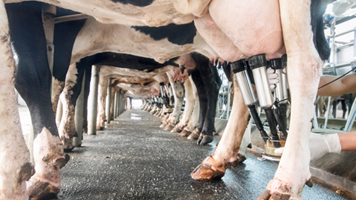Technology changes number of cows milked on farms
Category: Commentary, Dairy, Miscellaneous
 (AgriNews) – Much like other sectors of the agricultural industry technology has significantly impacted dairy operations.
(AgriNews) – Much like other sectors of the agricultural industry technology has significantly impacted dairy operations.
“Wisconsin has more milking machines per capita than any other place in the world, and when Wisconsin started becoming the dairy state in the early 1900s, cows were milked by hand,” said Douglas Reinemann, professor and associate dean for Outreach and Extension at the University of Wisconsin-Madison.
“One person could milk four cows per hour, and that is what really set the size of the farm, typically eight cows per farm,” Reinemann said during a presentation at the Agricultural Technology’s Impacts on Farming and the Rural Midwest conference organized by the Federal Reserve Bank of Chicago.
“In 1915, there were about 12 million U.S. farm workers and half of the population lived on farms,” he said.
During the ‘20s and ‘30s, some farms got milking machines which allowed dairymen to milk about 10 cows per hour.
“The implementation of milking technology closely followed the electrification of farms,” Reinemann said. “About one-half of the farms in Wisconsin were electrified before World War II and the other half were electrified after the war.”
Around 1990, pipeline milking systems were installed in dairy barns, which meant dairymen could milk 30 cows per hour.
“The standard farm was 60 cows and 240 acres,” Reinemann said.
“When they moved to milking parlors, dairymen could milk from 50 to 150 cows per hour, and this is when farms typically start to hire workers,” he said.
“Today, with rotary milking platforms, one person can milk 100 cows per hour,” Reinemann said. “The standard size is an 80-stall rotary system and a 3,000-cow herd.”
Robotic milking machines were first installed in European dairy operations about 1990.
“The first installation in the U.S. was in 2000 in Wisconsin,” Reinemann said. “The growth rate has been exponential, with no signs of slowing down even though the worldwide milk price for the last several years has been quite low.”
The robotic box system will milk from 50 to 70 cows per unit.
“These are usually on family farms that have about a 500-cow herd,” Reinemann said.
“One of the big economic performance indicators on a dairy farm is income over feed cost or how much milk is produced from a dollar input for feed,” he said. “A critical factor to pay for this expensive technology is to get more income over feed cost.”
Another factor in the investment cost is how many cows are milked with one robotic arm.
“The expensive part of the system is the robotic arm,” Reinemann said. “Pretty much everything else is the same — the milking unit and the stall.”
With a boxed robotic system, he said, from 60 to 70 cows can be milked with one arm.
“With a robotic rotary with a stationary arm, the number of cows milked per arm is two to three times the boxed system, so they will have a price advantage compared to the boxed system,” he said.
However, for individual cow management, Reinemann said, more can be done with a boxed system.
“That’s really where there is the biggest economic advantage, the ability to feed cows,” he said.
Also, there are some advantages of the variable milking interval in a boxed system.
“My high producing cows can be milked three to five times a day and the low producing cows two to three times a day,” Reinemann said.
“The boxed systems are friendlier to cows and people because there is a much better work and cow environment,” he said. “For the issues of animal welfare and public perception, I think the boxed systems have a clear advantage.”
The agricultural economy in Wisconsin is big, but declining as a percentage share of the state’s gross domestic product.
“What’s happened in the U.S. dairy market is that we’re a big enough exporter at about 15 to 16 percent that we’re locked into the world milk price,” Reinemann said.
“That has caused a decline in milk price over the last few years, and lots of farms are in financial crisis from an extended period of low milk price.”
Currently, about 8,200 dairy farms are operating in Wisconsin.
“In 1990, there were about 30,000 dairy farms in the state,” Reinemann said.
“This year, for the average farm to produce 100 pounds of milk, it costs $27, but the value is $19 per hundredweight,” he said. “That’s an $8 per hundredweight deficient, and it has been that way for two to three years and is likely to be that way for another year.”
About 18 percent of the cost of production is from overhead costs, Reinemann said.
“With robotic milkers, that will make that slice of the pie a little bigger at the 20 to 22 percent range, but the hired labor costs will come down, so the overall cost of production will also go down,” he said.
“Economically, we’re really close to a tipping point for this technology where economics are starting to look competitive,” Reinemann said. “I think this technology has the potential to move through the dairy industry very quickly.”




